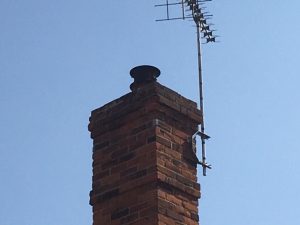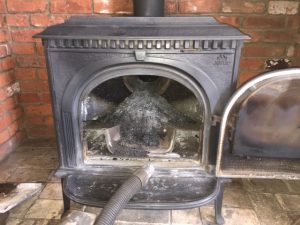
I’m doing so much safety work at the moment this week I will continue my blog with the theme of emergency call outs. Like last week this week’s emergency was a blocked chimney, although unlike last weeks blog the blockage was not so much in the flue but around the anti-bird cowl mesh. However, that is not to say that there was a significant amount of tar in the flue as well. As tar is most likely to be deposited in the colder parts of the chimney and a chimney becomes increasingly colder the higher up the stack and will be its coldest at the terminal, its not difficult to understand that the majority of tar will be deposited at the top of the stack and as in this case in the cowl/terminal. It’s a little difficult to see in the photograph, but in this instance, tar had totally blocked the mesh around the cowl so that the hot flue gases had no means of escaping the chimney. The result of this being that the hot flue gases were forced back down the chimney and out of the stove into the customers living room. Indeed, this is why the customer had called me; reporting that the stove was smokey and which was filling the room with smoke every time they lit the stove. As can be observed from the photograph, the stove is a Jotul 8 Wood-burning Stove.
The customers were an elderly couple who told me they lit the stove most days and they relied upon it for additional heat as they both felt the cold even on a warm day. I asked them about their burning practices, and they told me that in the evenings before they went to bed, they shut the stove down completely and let it smolder overnight. I explained to them at some length why this was far from best practice, describing how incomplete combustion through starving the fire of oxygen would lead to tar build up in their chimney and pollution being released into the atmosphere. I pointed out that this was probably the cause of the blockage in his chimney and I advised them regarding the correct use of their stove and optimum burning practices.

I was able to successfully clear the cowl of the blocking tar by using rotary power sweeping equipment with a small scrubber cleaning attachment. This attachment is formed from nylon strands that a spun around quickly on the end of special click rods by an 18-volt drill. The nylon strands of the small scrubber attachment have the effect of lightly flicking off the tar from the cowl and inside the liner without causing any damage to these structures. As can be seen in the photos, a significant amount of tar was removed from both cowl and liner, ending up in the bottom of the stove.
In these unusual times, I was able to safely carry out the work by practicing social distancing with the customers who remained in an adjoining room and I was able to speak to them through an open door. I wore full PPE including two pairs of gloves and a facemask with a 3M filter, both the customers also wore facemasks, so we were all able to stay safe and get the job done. The customer even paid online so that there was no exchange of paper! As people are saying, this is the ‘new normal’ and for the time being this is the way we will all have to work, as it does not appear that the Covid-19 Virus will not be going away in the near future.


 My name is Paddy McKeown, I am a retired police officer (Detective Sergeant – Metropolitan Police), turned chimney sweep. I have completed training with ‘The Guild of Master Chimney Sweeps’, and Rod Tech UK (Power Sweeping).
My name is Paddy McKeown, I am a retired police officer (Detective Sergeant – Metropolitan Police), turned chimney sweep. I have completed training with ‘The Guild of Master Chimney Sweeps’, and Rod Tech UK (Power Sweeping).




Comments are closed.